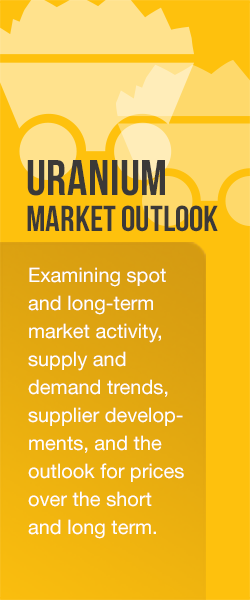“Hedgemony”
For some time now, there has been concern in the uranium industry about the influence of hedge and investment funds on price formation. Today, that concern made front page news in The Wall Street Journal in a story entitled, “New Exotic Focus for Hedge Funds: Uranium Market,” with the descriptive subtitle: “Speculators Drive Up Price, Irking Utilities; Adit Capital’s Big Bet.”
There is no question that speculators (these include not only hedge and investment funds, but traditional traders in the uranium market) have had a large impact on price. Our concern has always been that some in the industry see the recent price run-up as entirely being generated by hedge/investment fund buying, and not by more fundamental supply/demand issues. A corollary of this is the belief that when the fund buying stops, price will revert to its previous lows.
To this end, in our current survey of the industry, we asked the question: “What do you believe has been the primary factor in the dramatic rise in uranium prices?” Four choices were given:
• Purchases by hedge funds/investment funds,
• Floods and other problems at uranium mines,
• New reactors being built in China, Russia, and India, and
• Long period of low prices leading to lack of investment in production/exploration.
Survey participants were also allowed to specify another primary cause beyond the four mentioned here, listed in the chart to the right as Other Factors.
While the survey is still ongoing (and we encourage you to complete yours if you have not already done so), the results in the chart clearly indicate that the overwhelming majority of those who have already responded see the long drought in price and the associated effect on production and exploration as the main factor affecting price. Only a few picked other categories, with a couple selecting hedge and investment fund buying, another two choosing floods and other production problems, and five specifying other factors.
The question boils down to one of cause and effect. It is clear that the funds saw a supply/demand imbalance and pounced on it, and this additional demand certainly accelerated the price rise. This role of the hedge funds is captured in the remark by the NEI’s Marv Fertel who was interviewed for the WSJ article. In commenting on the effect of fund buying, Fertel said ‘“All it does is take what’s somewhat scarce and make it scarcer.”‘ In this vein, the article notes that NEI has recommended to DOE that it exclude anyone but end users from its future uranium auctions.
While we agree with the sentiment of the scarcity statement, it is probably more correct to say the funds are willing to pay more for a scarce commodity than others are, in anticipation of its price going even higher in the future and thus generating gains. In the near term, this buying makes uranium more difficult to come by for utilities, but in the longer term, higher prices make uranium more plentiful, not scarcer. Fertel acknowledges this eventuality in the WSJ article when he is quoted as saying, “I think we’re going to end up with a much better situation than we even had before,” that situation presumably meaning a much more solid uranium supply base.
The problem is what happens before we get to this better situation. It is possible for prices to get bid up to very high levels – much higher than necessary to generate the requisite amount of uranium to meet requirements in the future. To this end, it is worth asking the question: “Are you really going to get that much more production if price is pushed up to $200 (like the WSJ says some bulls believe) as opposed to $100 a pound?” In this regard, just as past low prices understated the scarcity of uranium, it is possible that high prices may overstate the future scarcity. Naturally, such bloated prices tend to irk utilities.
Looking at the problem more broadly, high prices may do more than just hit utilities in the pocketbook with respect to current reactor operations. If price goes high enough, it is possible that it would dissuade some companies from ordering reactors, or at least delay ordering reactors until the trend of rising prices ends.
This makes for an interesting choice for DOE, which has uranium inventories to sell. Does it seek to maximize revenue and sell to everyone, or sell selectively as NEI recommends. The problem may not be the absolute scarcity of uranium in the short term (i.e., that utilities won’t have enough uranium to fuel their reactors), but that higher prices might dissuade reactor orders. So far, DOE has been careful not to interfere with the price rise, recognizing that prices needed to increase to stimulate the necessary production to support nuclear power growth. And, while the market may now be overheated, the market that existed before the hedge fund buying commenced was clearly “underheated,” as the low prices that existed then failed to signal how dire the supply situation was becoming.
One question is how the increased publicity of this speculative activity will affect the future participation of hedge and investment funds in the uranium market. On the one hand, hedge funds prefer to shy away from publicity (although obviously some don’t mind the attention) – and you can’t get any more publicity than a front page article in The WSJ, so this would suggest that fund activity would decline. On the other hand, other hedge funds may now recognize that the uranium market is the place to play, and thus fund buying could increase.
At some point, hedge fund interest in uranium will wane, but this doesn’t necessarily mean that the financial community will not play a more integral role in the market, as the volume of uranium transactions increases and opportunities exist to make the uranium market operate more efficiently.


